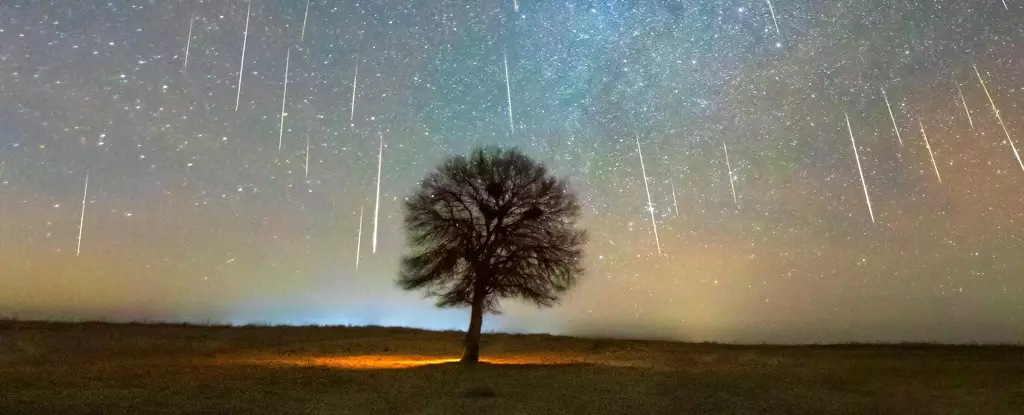As an astronomer and meteor enthusiast, I eagerly anticipate the arrival of the Geminid meteor shower every December. Considered the best natural fireworks display of the year, people from all around the world gather to witness this breathtaking celestial event. This year’s Geminid meteor shower holds even greater promise as it coincides with a new moon, resulting in a beautifully dark night sky that will enhance the show. In this article, we will explore the origins of the Geminid meteor shower, why it is such a remarkable phenomenon, and provide tips for optimum viewing.
The Geminid meteor shower occurs annually in December when Earth passes through a stream of debris left behind by an asteroid known as (3200) Phaethon. Unlike most asteroids, Phaethon follows a highly elongated orbit that brings it closer to the Sun than Mercury and farther away than Mars. This orbit subjects Phaethon to extreme temperature variations, causing its surface to shatter, resulting in the release of dust into space. Over time, this scattered dust spreads along Phaethon’s orbit, forming a tube of debris. When Earth intersects this debris stream, the Geminid meteor shower is born.
The Geminids are named after the constellation Gemini, as their radiant point lies within this celestial formation. Each grain of dust from Phaethon’s debris stream that enters Earth’s atmosphere creates a bright meteor, which is visible above 80 kilometers altitude. The size and speed of the dust grain determine the intensity of the resulting flash. As Earth orbits the Sun, it encounters streams of dust and debris from asteroids and comets, generating meteor showers. The Geminids produce over 100 meteors per hour at their peak from the perspective of the northern hemisphere, offering a remarkable spectacle to observers. Even from Australia, one can witness over 50 meteors per hour at the zenith of the shower, making it a captivating experience.
To fully appreciate the Geminid meteor shower, it is crucial to understand the best viewing conditions. The radiant point, from which the meteors appear to radiate, needs to be above the horizon for the meteors to be visible. The time at which the radiant rises varies depending on one’s location. The higher the radiant is in the sky, the more meteors will be visible. The table below provides the rising and culmination times of the radiant for major cities on December 14.
The peak rate estimates the number of meteors visible during the hour when the radiant is at its highest. However, this estimate assumes perfect eyesight and a dark, clear sky. Factors such as light pollution, visual acuity, and cloud cover affect the actual number of meteors observed. The best viewing experience occurs during the four-hour period centered around the culmination of the radiant. As time passes from the culmination, the meteor rate diminishes. Nevertheless, there is still a chance to witness Geminids as long as the radiant remains above the horizon, with respectable rates visible even an hour after its rise.
While Geminid meteors can appear anywhere in the night sky, their movement can be traced back to the radiant point in the constellation Gemini. To optimize meteor spotting, it is recommended to find and face the radiant, then shift your gaze approximately 45 degrees to the left or right. This method allows for a broader field of view and a higher chance of observing meteors. Due to the changing position of the radiant throughout the night, viewers must adjust their focus accordingly. Lying down while looking up at a 45-degree angle is ideal to prevent a sore neck. Additionally, choosing a side with less light pollution will enhance the overall experience.
The Geminid meteor shower is a remarkable natural phenomenon that is best enjoyed with others. Gather your friends or loved ones and venture to a dark, picturesque location for optimum viewing. With summer in full swing in Australia, it presents an ideal opportunity to embark on a memorable camping trip. To find the perfect viewing spot, consult an interactive map displaying Australia’s most and least light-polluted locations.
As the Geminid meteor shower approaches, anticipation builds for this spectacular celestial event. The convergence of Phaethon’s debris stream with Earth’s orbit creates a mesmerizing display of meteors. By understanding the origins and optimal viewing conditions, one can fully appreciate the majesty of the Geminid meteor shower. Grab your loved ones, find a dark spot in the night sky, and prepare for an awe-inspiring experience as nature’s fireworks light up the heavens above.


Leave a Reply